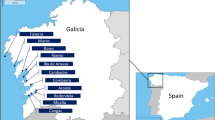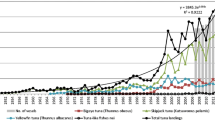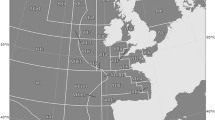Abstract
Background, aim, and scope
Two fishing methods, creeling and conventional trawling, are used to target Norway lobster (Nephrops norvegicus), economically the second most important species in Swedish west coast fisheries. The goal was to evaluate overall resource use and environmental impact caused by production of this seafood with the two different fishing methods using life cycle assessment (LCA) methodology.
Materials and methods
The inventory covered the entire chain starting by production of supply materials and the fishery itself, through seafood auctioning, wholesaling, retailing, to the consumer. That portion of the life cycle occurring on land was assumed to be identical for Norway lobsters regardless as to how they were caught. The functional unit was 300 g of edible meat (i.e., Norway lobster tails), corresponding to 1 kg of whole, boiled Norway lobsters. The seafloor impact of trawling was quantified using a recently developed methodology.
Results
Major differences were found between the fishing methods with regard to environmental impact: creeling was found to be more efficient than conventional trawling in all traditional impact categories and in the two additional fishery-related categories involving seafloor impact and discarding. Since the quality of the creel-caught Nephrops was higher, the difference was probably even higher than indicated here.
Discussion
Major improvement potential was identified in the more widespread use of creels and species-selective trawls. The only deficiencies of creel fishing were poorer working environment and safety, and a potentially higher risk of recruitment overfishing. However, these issues could be handled by technological development and fisheries regulations and should not hamper the development of creel fishery.
Conclusions
Improvement options were identified and quantified for the Swedish Nephrops fishery. The study demonstrates how LCA can be used to compare the environmental performance of different segments of a fishery.
Recommendations and perspectives
Shifting to creeling and species-selective trawling would lead to considerably lower discard, fuel use, and seafloor impact while providing consumers with the same amount of Norway lobsters.





Similar content being viewed by others
References
Anon (2000) Ecoinvent 1.2, Swiss Centre for Life Cycle Inventories. http://www.ecoinvent.ch/
Anon (2001) Småskaligt kustfiske och insjöfiske: en analys (Small scale fisheries and lake fisheries: an analysis, in Swedish). National Board of Fisheries, fiskeriverket@fiskeriverket.se
Anon (2002) EUNIS Habitat classification. European Environment Agency. http://eunis.eea.eu.int/index.jsp
Anon (2003) A desk-study of diverse methods of fishing when considered in perspective of responsible fishing, and the effect on the ecosystem caused by fishing activity. TemaNord report 2003:501, Nordic Council of Ministers
Anon (2004) Marine life information network: biology and sensitivity key information sub-programme (online) Plymouth: Marine Biological Association of the United Kingdom (cited 08/02/2006), http://www.marlin.ac.uk
Anon (2006) Effekterna av utflyttad trålgräns på fisk och bottenfauna. Analys av ökad användning av passiva redskap innanför trålgränsen samt de ekonomiska konsekvenserna för näringen (in Swedish). Swedish Board of Fisheries, fiskeriverket@fiskeriverket.se
Ask L, Westerberg H (2007) Fiskbestånd och miljö i hav och sötvatten. Resurs-och miljööversikt 2007 (Fish stocks and environment in marine and fresh waters. overview over resources and environment 2007, in Swedish). National Board of Fisheries, fiskeriverket@fiskeriverket.se
Ayer N, Tyedmers P, Pelletier N, Sonesson U, Scholz AJ (2007) Co-product allocation in Life Cycle Assessments of seafood production systems: Review of problems and strategies. Int J LCA 12(7):480–487
Catchpole TL, Frid CLJ, Gray TS (2006) Resolving the discard problem—a case study of the English Nephrops fishery. Mar Pol 30(6):821–831
ESRI (2004) ArcGIS/ArcView/ArcMap version 9.0 Environmental Systems Research Institute, Redlands, CA, USA
Evenbratt H (2005) QIM (Quality Index Method) assessment of cod and Norway lobster caught by various fishing methods. Student thesis, Chalmers University of Technology, Dep. of Chemical Engineering/Food science, p 38
FAO (2007) Information on distribution of and global landings of Nephrops norvegicus on FAO website: http://www.fao.org/fi/website/FIRetrieveAction.do?dom=species&fid=2647 (cited 20/08/2007)
ISO (2002) ISO 14000:2002. Svenska standarder för miljöledning (Swedish standards for environmental management, in Swedish/English). SIS Förlag
Kelleher K (2005) Discards in the world’s fisheries. An update. FAO Fisheries Technical Paper 470, p 131
Nilsson P, Ziegler F (2007) Spatial distribution of fishing effort in relation to seafloor habitats of the Kattegat, a GIS analysis. Aq Cons: Mar Freshw Ecos 17(4):421–440
PRé Consultants (2004) SimaPro Analyst 6.0.4. Amersfoort, The Netherlands
Thrane M (2004a) Energy consumption in the Danish fishery. J Ind Ecol 8:223–239
Thrane M (2004b) Environmental impacts from Danish fish products, hot spots and environmental policies. Doctoral dissertation, Dept. of Development and Planning, Aalborg University, Aalborg
Thrane M (2006) LCA of Danish fish products. New methods and insights. Int J Life Cycle Assess 11(1):66–74
Tyedmers PH (2001) Energy consumed by North Atlantic fisheries. In: Fisheries impacts on North Atlantic ecosystems: catch, effort and national/regional datasets. Fish Cent Res Rep 9(3):12–34
Ulmestrand M, Valentinsson D, Sangster GI, Bova DJ, Kynoch RJ, Breen M, Graham GN, Soldal AV, Cruickshank O, Moth-Poulsen T, Lowry N (1998) Nephrops survival after escape from commercial fishing gear discarded from deck. In: Report of the study group on Life Histories of Nephrops. ICES CM 1998/G9, pp 104–110
Valentinsson D (2006) Mandatory use of species-selective grids in the Swedish Nephrops trawl fishery on national waters. Experiences after two years. Report. National Board of Fisheries, Institute of Marine Research, Lysekil (available as manuscript from: daniel.valentinsson@fiskeriverket.se)
Valentinsson D, Ulmestrand M (2008) Species selective Nephrops trawling: Swedish grid experiments. Fish Res 90(1):109–117
Wileman DA, Sangster GI, Breen M, Ulmestrand M, Soldal AV, Harris RR (1999) Roundfish and Nephrops survival after escape from commercial fishing gear. EC Contract No FAIR-CT95–0753. Final Report 1999, 125 pp + app
Ziegler F (2006) Environmental life cycle assessment of Norway lobster (Nephrops norvegicus) caught along the Swedish west coast by creels and conventional trawls. A data report. SIK report 746, SIK, Göteborg, 36 pp (available as manuscript from SIK library: hr@sik.se)
Ziegler F, Hansson P-A (2003) Emissions from fuel combustion in Swedish cod fishery. J Clean Prod 11:303–314
Ziegler F, Nilsson P, Mattsson B, Walther Y (2003) Life cycle assessment of frozen cod fillets including fishery-specific environmental impacts. Int J Life Cycle Assess 8:39–47
Acknowledgements
We would like to thank all those who spent time helping us gather the data for this study. First and foremost, we thank the 19 anonymous fishermen who most kindly provided us with data by completing the questionnaire. We would also like to thank all those who helped gather data regarding the life cycle on land and all the on-board observers at the Institute of Marine Research, Lysekil, who helped us with data collection. The Knowledge Foundation is acknowledged for financial support.
Author information
Authors and Affiliations
Corresponding author
Additional information
Responsible Editor: Nils Jungbluth
Electronic Supplementary Material
Below is the link to the electronic supplementary material.
ESM
(PDF 48.0 KB)
Rights and permissions
About this article
Cite this article
Ziegler, F., Valentinsson, D. Environmental life cycle assessment of Norway lobster (Nephrops norvegicus) caught along the Swedish west coast by creels and conventional trawls—LCA methodology with case study. Int J Life Cycle Assess 13, 487–497 (2008). https://doi.org/10.1007/s11367-008-0024-x
Received:
Accepted:
Published:
Issue Date:
DOI: https://doi.org/10.1007/s11367-008-0024-x




